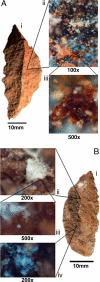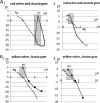From the Cover: Implications for complex cognition from the hafting of tools with compound adhesives in the Middle Stone Age, South Africa
- PMID: 19433786
- PMCID: PMC2700998
- DOI: 10.1073/pnas.0900957106
From the Cover: Implications for complex cognition from the hafting of tools with compound adhesives in the Middle Stone Age, South Africa
Abstract
Compound adhesives made from red ochre mixed with plant gum were used in the Middle Stone Age (MSA), South Africa. Replications reported here suggest that early artisans did not merely color their glues red; they deliberately effected physical transformations involving chemical changes from acidic to less acidic pH, dehydration of the adhesive near wood fires, and changes to mechanical workability and electrostatic forces. Some of the steps required for making compound adhesive seem impossible without multitasking and abstract thought. This ability suggests overlap between the cognitive abilities of modern people and people in the MSA. Our multidisciplinary analysis provides a new way to recognize complex cognition in the MSA without necessarily invoking the concept of symbolism.
Conflict of interest statement
The authors declare no conflict of interest.
Figures



Comment in
-
Hafted spears and the archaeology of mind.Proc Natl Acad Sci U S A. 2009 Jun 16;106(24):9544-5. doi: 10.1073/pnas.0904369106. Epub 2009 Jun 8. Proc Natl Acad Sci U S A. 2009. PMID: 19506246 Free PMC article. No abstract available.
References
-
- Amati D, Shallice T. On the emergence of modern humans. Cognition. 2007;103:358–385. - PubMed
-
- Barnard PJ, Duke DJ, Byrne RW, Davidson I. Differentiation in cognitive and emotional meanings: an evolutionary analysis. Cogn Emot. 2007;21:1155–1183.
-
- Mazza PPA, et al. A new Palaeolithic discovery: Tar-hafted stone tools in a European Mid-Pleistocene bone-bearing bed. J Archaeol Sci. 2006;33:1310–1318.
-
- Boëda LE, et al. Bitumen as a hafting material on Middle Palaeolithic artefacts. Nature. 1996;380:336–338.
-
- Ambrose SH. Chronology of the Later Stone Age and food production in East Africa. J Archaeol Sci. 1998;25:377–392.
Publication types
MeSH terms
Substances
LinkOut - more resources
Full Text Sources

